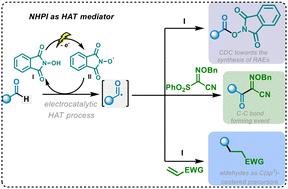当前位置:
X-MOL 学术
›
Org. Chem. Front.
›
论文详情
Our official English website, www.x-mol.net, welcomes your feedback! (Note: you will need to create a separate account there.)
Acyl radicals generated from aldehydes with NHPI as electrocatalyst: aldehydes and alcohols as carbon-centered radical precursors
Organic Chemistry Frontiers ( IF 4.6 ) Pub Date : 2024-07-17 , DOI: 10.1039/d4qo01067a Rodrigo G. Enríquez 1 , Juan S. Dato-Santiago 1 , Roberto del Río-Rodríguez 1 , José Alemán 1, 2, 3 , Jose A. Fernández-Salas 1, 2
Organic Chemistry Frontiers ( IF 4.6 ) Pub Date : 2024-07-17 , DOI: 10.1039/d4qo01067a Rodrigo G. Enríquez 1 , Juan S. Dato-Santiago 1 , Roberto del Río-Rodríguez 1 , José Alemán 1, 2, 3 , Jose A. Fernández-Salas 1, 2
Affiliation

|
In this work, we describe how N-hydroxyphthalimide (NHPI) promotes hydrogen atom transfer from aldehydes under electrocatalytic chemical conditions. This involves the generation of phthalimide-N-oxyl (PINO), which abstracts an acyl hydrogen to produce acyl radicals from aldehydes. These acyl radicals then react with oximes or another PINO radical to form redox-active esters (RAEs). Additionally, we detail a Giese-type reaction with electron-deficient alkenes via electrochemical reduction of the generated RAE derivatives. This process produces sp3-carbon centered radicals from aldehydes. We also extend this method to aliphatic alcohols, involving a multi-step electrochemical process to form carbon-centered radicals from readily available alcohols.
中文翻译:

以 NHPI 作为电催化剂从醛产生酰基自由基:醛和醇作为碳中心自由基前体
在这项工作中,我们描述了 N-羟基邻苯二甲酰亚胺 (NHPI) 如何在电催化化学条件下促进氢原子从醛转移。这涉及邻苯二甲酰亚胺-N-氧基(PINO)的生成,它可以提取酰基氢,从醛中产生酰基自由基。然后这些酰基自由基与肟或另一个 PINO 自由基反应形成氧化还原活性酯 (RAE)。此外,我们还详细介绍了通过电化学还原生成的 RAE 衍生物与缺电子烯烃进行吉斯型反应。该过程从醛产生 sp 3 -碳中心自由基。我们还将这种方法扩展到脂肪醇,涉及多步骤电化学过程,从容易获得的醇形成以碳为中心的自由基。
更新日期:2024-07-17
中文翻译:

以 NHPI 作为电催化剂从醛产生酰基自由基:醛和醇作为碳中心自由基前体
在这项工作中,我们描述了 N-羟基邻苯二甲酰亚胺 (NHPI) 如何在电催化化学条件下促进氢原子从醛转移。这涉及邻苯二甲酰亚胺-N-氧基(PINO)的生成,它可以提取酰基氢,从醛中产生酰基自由基。然后这些酰基自由基与肟或另一个 PINO 自由基反应形成氧化还原活性酯 (RAE)。此外,我们还详细介绍了通过电化学还原生成的 RAE 衍生物与缺电子烯烃进行吉斯型反应。该过程从醛产生 sp 3 -碳中心自由基。我们还将这种方法扩展到脂肪醇,涉及多步骤电化学过程,从容易获得的醇形成以碳为中心的自由基。












































 京公网安备 11010802027423号
京公网安备 11010802027423号